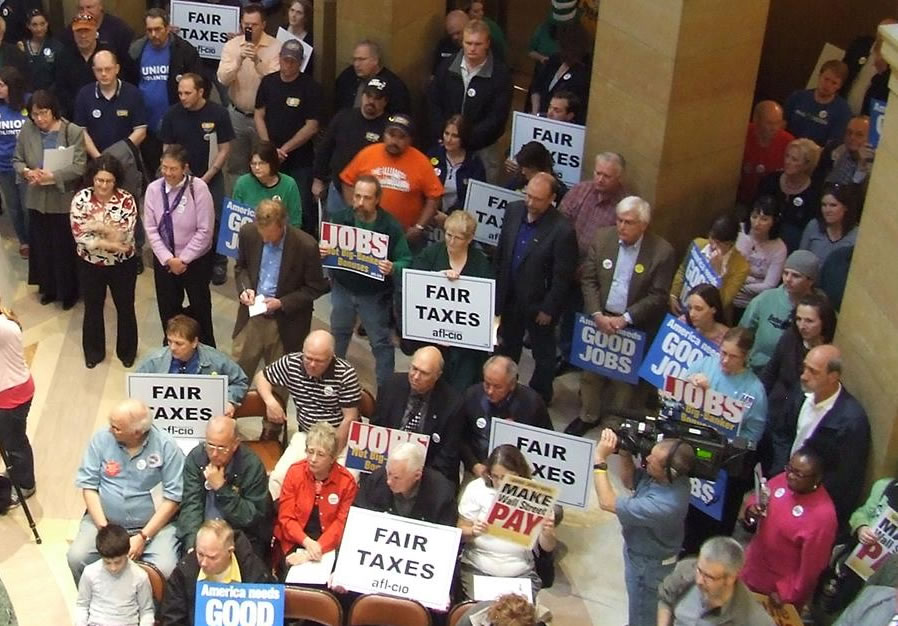

Share
The Minnesota Legislature convenes for a shortened session Tuesday, facing a range of issues including infrastructure investment, transportation funding and a $900 million budget surplus.
Lawmakers must adjourn by May 23, leaving the Republican-controlled House and DFL-controlled Senate about 11 weeks to approve and send legislation to Governor Mark Dayton.
Minnesota unions say they hope lawmakers will use some of the budget surplus to aid unemployed Iron Range workers and boost public education. In addition, they seek long-term investment in roads, bridges, transit and other infrastructure.
“Thousands of Iron Range miners have been laid off, and another 700 more Minnesotans who work for vendors that support the mining industry have also lost their job,” the Minnesota AFL-CIO said. “Foreign steel dumping has pushed ore prices to a 10-year low and devastated more than half of the 11 mining operations on the Range.”
The state labor federation, the United Steelworkers and other affiliates seek an extension of unemployment benefits to help workers hit by the downturn.
Last month, the state announced the budget surplus is expected to be $900 million, down from an earlier projection of $1.2 billion.
“While slower economic growth has decreased Minnesota’s budget surplus, we are still outperforming our neighbors in nearly every indicator,” noted Minnesota AFL-CIO President Bill McCarthy.
“However, the slower economic growth should be a warning to lawmakers not to squander the surplus on tax giveaways to corporations and the richest Minnesotans or drain the unemployment insurance fund.
“Now is the time to invest in priorities that support working families like universal pre-K, new revenue to fix our crumbling transportation system, and relief for laid off workers on the Iron Range.”
Denise Specht, president of Education Minnesota, concurred. “The decrease in the projected surplus will force policymakers to choose between tax cuts for the wealthy few and investments that benefit the whole state,” she said. “The educators of Minnesota hope the Legislature makes the right choice and invests in children and working families.”
More than 200 organizations, including labor unions and businesses, are part of a campaign called “Progress in Motion” that is seeking action on a comprehensive transportation funding plan for the state.
“With 50 percent of the state’s roads and bridges more than 50 years old and 1,000 of the state’s bridges structurally insufficient, the time is now for lawmakers to approve a long-term, dedicated source of funding to repair and expand Minnesota’s highways,” said Margaret Donahoe, executive director of the Minnesota Transportation Alliance.
“Progress in Motion” has placed billboards highlighting specific road projects that need to be done throughout the state.
In January, Governor Dayton proposed investing $1.4 billion in infrastructure improvements across Minnesota. He called the bonding proposal a “jobs bill” and, drawing on academic research, estimated it would create work for nearly 40,000 Minnesotans. [The calculation does not include an additional $600 million Dayton’s proposal would leverage in private, federal and local funds.]
The measure quickly drew support from two of the state’s top labor leaders.
“Governor Dayton continues to build on his legacy of maintaining Minnesota’s infrastructure for generations to come,” said Harry Melander, president of the Minnesota Building and Construction Trades Council. “It’s a legacy of not only maintaining our infrastructure, but also providing good, well-paying jobs for working people throughout our state.”
Minnesota AFL-CIO President McCarthy said, “Upgrading infrastructure is one of the smartest things state government can do for our economy.”
The jobs bill would provide upgrades or repairs to bridges, rail crossings, water treatment facilities, higher-education facilities, wetlands and other assets across Minnesota.
Bonding bills require a three-fifths majority vote — 81 representatives and 41 senators — in order to pass.
This article contains information from the St. Paul Union Advocate and Minneapolis Labor Review.

